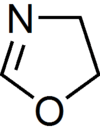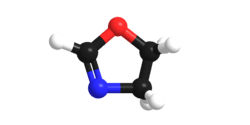Oxazoline
Oxazoline is a five-membered heterocyclic chemical compound containing one atom each of oxygen and nitrogen. It was likely first synthesized in 1884[2] but it was not until 5 years later that Siegmund Gabriel correctly assigned the structure.[3] It was named in-line with the Hantzsch–Widman nomenclature and is part of a family of heterocyclic compounds, where it exists between oxazole and oxazolidine in terms of saturation.
 | |
 | |
| Names | |
|---|---|
| IUPAC name
2-oxazoline | |
| Systematic IUPAC name
4,5-dihydrooxazole | |
| Other names
Δ2-oxazoline | |
| Identifiers | |
| |
3D model (JSmol) |
|
| ChemSpider | |
| ECHA InfoCard | 100.007.274 |
PubChem CID |
|
| UNII |
|
CompTox Dashboard (EPA) |
|
| |
| |
| Properties | |
| C3H5NO | |
| Molar mass | 71.079 g·mol−1 |
| Density | 1.075 [1] |
| Boiling point | 98 °C (208 °F; 371 K)[1] |
Except where otherwise noted, data are given for materials in their standard state (at 25 °C [77 °F], 100 kPa). | |
| Infobox references | |
Oxazoline itself has no current applications however compounds containing the ring, which are referred to as oxazolines or oxazolyls, have a wide variety of uses; particularly as ligands in asymmetric catalysis, as protecting groups for carboxylic acids and increasingly as monomers for the production of polymers.
Isomers
 2‑oxazoline, 3‑oxazoline, and 4‑oxazoline (from left to right) |
Three structural isomers of oxazoline are possible depending on the location of the double bond, however only 2‑oxazolines are common. 4‑Oxazolines are formed as intermediates during the production of certain azomethine ylides[4] but are otherwise rare. 3‑Oxazolines are even less common but have been synthesised photochemically[5] and by the ring opening of azirines.[6] These three forms do not readily interconvert and hence are not tautomers.
A fourth isomer exists in which the O and N atoms are adjacent, this is known as isoxazoline. |
Synthesis
The synthesis of 2-oxazoline rings is well established and in general proceeds via the cyclisation of a 2-amino alcohol (typically obtained by the reduction of an amino acid) with a suitable functional group.[7][8][9] The overall mechanism is usually subject to Baldwin's rules.
From acid chlorides
A routine route to oxazolines entails reactions of acyl chlorides with 2-amino alcohols. Thionyl chloride is commonly used to generate the acid chloride in situ, care being taken to maintain anhydrous conditions, as oxazolines can be ring-opened by chloride if the imine becomes protonated.[10] The reaction is typically performed at room temperature. If reagents milder than SOCl2 are required, oxalyl chloride can be used.[11]
Aminomethyl propanol is the classical precursor to oxazolines using acid chloride method.[12] As applied to fatty acids, the resulting dimethyloxazoline (DMOX) derivatives are amenable to analysis by gas chromatography.
From carboxylic acids
Modification of the Appel reaction allows for the synthesis of oxazoline rings.[13] This method proceeds under relatively mild room temperature conditions, however, owing to the large amounts of triphenylphosphine oxide produced, the method is not ideal for large-scale reactions. The use of this method is becoming less common, due to carbon tetrachloride being restricted under the Montreal protocol.
From aldehydes
The cyclisation of an amino alcohol and an aldehyde produces an intermediate oxazolidine which can be converted to an oxazoline by treatment with a halogen-based oxidising agent (e.g. NBS,[14] or iodine[15]); this potentially proceeds via an imidoyl halide. The method has been shown to be effective for a wide range of aromatic and aliphatic aldehydes however electron rich aromatic R groups, such as phenols, are unsuitable as they preferentially undergo rapid electrophilic aromatic halogenation with the oxidising agent.
From nitriles
The use of catalytic amounts of ZnCl2 to generate oxazolines from nitriles was first described by Witte and Seeliger,[16][17] and further developed by Bolm et al.[18] The reaction requires high temperatures to succeed and is typically performed in refluxing chlorobenzene under anhydrous conditions. A precise reaction mechanism has never been proposed, although it is likely similar to the Pinner reaction; preceding via an intermediate amidine.[19][20] Limited research has been done into identifying alternative solvents or catalysts for the reaction.[21][22]
Ligands
Ligands containing a chiral 2-oxazoline ring are used in asymmetric catalysis due to their facile synthesis, wide range of forms and effectiveness for many types of catalytic transformation.[23][24]
2-Substituted oxazolines can be prepared by many methods and possess a moderately hard N-donor. Chirality is easily incorporated by using 2-amino alcohols prepared by the reduction of amino acids; which are both optically pure and inexpensive. As the stereocentre in such oxazolines is adjacent to the coordinating N-atom, it can influence the selectivity of processes occurring at the metal centre. The ring is thermally stable[25] and resistant to nucleophiles, bases, radicals, and weak acids[26] as well as being fairly resistant to hydrolysis and oxidation;[7] thus it can be expected to remain stable in a wide range of reaction conditions.
Major classes of oxazoline based ligand include:
Notable specialist oxazoline ligands include:
- Phenol-oxazolines
- Bis(oxazolinato)s
- Trisoxazolinylborate ligands
Polymers
2-Oxazolines, such as 2-ethyl-2-oxazoline, can undergo living cationic ring-opening polymerisation to form poly(2-oxazoline)s.[27] These are polyamides and can be regarded as analogues of peptides; they have numerous potential applications[28] and have received particular attention for their biomedical uses.[29][30]
See also
Structural analogues
- Benzoxazole: where the oxazoline is fused onto a benzene ring.
- Oxazole: which has two double bonds
- Oxazolidine: which has no double bonds
- Thiazoline: where the oxygen is replaced by sulphur
Other pages
- Aminorex a drug bearing an oxazoline ring
References
- Wenker, H. (1938). "Syntheses from Ethanolamine. V. Synthesis of Δ2-Oxazoline and of 2,2'-Δ2-Dioxazoline". Journal of the American Chemical Society. 60 (9): 2152–2153. doi:10.1021/ja01276a036.
- Andreasch, Rudolf (December 1884). "Zur Kenntniss des Allylharnstoffs" [To the knowledge of the alkyl urea]. Monatshefte für Chemie (in German). 5 (1): 33–46. doi:10.1007/BF01526087.
- Gabriel, S. (1889). "Zur Kenntniss des Bromäthylamins" [To the knowledge of the Bromäthylamins]. Berichte der Deutschen Chemischen Gesellschaft (in German). 22 (1): 1139–1154. doi:10.1002/cber.188902201248.
- Vedejs, E.; Grissom, J. W. (1988). "4-Oxazoline route to stabilized azomethine ylides. Controlled reduction of oxazolium salts". Journal of the American Chemical Society. 110 (10): 3238–3246. doi:10.1021/ja00218a038.
- Armesto, Diego; Ortiz, Maria J.; Pérez-Ossorio, Rafael; Horspool, William M. (1983). "A novel photochemical 1,2-acyl migration in an enol ester. The synthesis of 3-oxazoline derivatives". Tetrahedron Letters. 24 (11): 1197–1200. doi:10.1016/S0040-4039(00)86403-5.
- Sá, Marcus C. M.; Kascheres, Albert (1996). "Electronically Mediated Selectivity in Ring Opening of 1-Azirines. The 3-X Mode: Convenient Route to 3-Oxazolines". The Journal of Organic Chemistry. 61 (11): 3749–3752. doi:10.1021/jo9518866. PMID 11667224.
- Wiley, Richard H.; Bennett, Leonard L. (1949). "The Chemistry of the Oxazolines". Chemical Reviews. 44 (3): 447–476. doi:10.1021/cr60139a002.
- Frump, John A. (1971). "Oxazolines. Their preparation, reactions, and applications". Chemical Reviews. 71 (5): 483–505. doi:10.1021/cr60273a003.
- Gant, Thomas G.; Meyers, A.I. (1994). "The chemistry of 2-oxazolines (1985–present)". Tetrahedron. 50 (8): 2297–2360. doi:10.1016/S0040-4020(01)86953-2.
- Holerca, Marian N.; Percec, Virgil (2000). "1H NMR Spectroscopic Investigation of the Mechanism of 2-Substituted-2-Oxazoline Ring Formation and of the Hydrolysis of the Corresponding Oxazolinium Salts". European Journal of Organic Chemistry. 2000 (12): 2257–2263. doi:10.1002/1099-0690(200006)2000:12<2257::AID-EJOC2257>3.0.CO;2-2.
- Evans, David; Peterson, Gretchen S.; Johnson, Jeffrey S.; Barnes, David M.; Campos, Kevin R.; Woerpel, Keith A. (1998). "An Improved Procedure for the Preparation of 2,2-Bis[2-[4(S)- tert-butyl-1,3-oxazolinylpropane [(S,S)-tert-Butylbis(oxazoline)] and Derived Copper(II) Complexes". J. Org. Chem. 63 (13): 4541–4544. doi:10.1021/jo980296f.
- Albert I. Meyers, Mark E. Flanagan (1993). "2,2'-Dimethoxy-6-Formylbiphenyl". Org. Synth. 71: 107. doi:10.15227/orgsyn.071.0107.CS1 maint: uses authors parameter (link)
- Vorbrüggen, Helmut; Krolikiewicz, Konrad (1993). "A simple synthesis of Δ2-oxazines, Δ2-oxazines, Δ2-thiazolines and 2-substituted benzoxazoles". Tetrahedron. 49 (41): 9353–9372. doi:10.1016/0040-4020(93)80021-K.
- Schwekendiek, Kirsten; Glorius, Frank (2006). "Efficient Oxidative Synthesis of 2-Oxazolines". Synthesis. 2006 (18): 2996–3002. doi:10.1055/s-2006-950198.
- Ishihara, Midori; Togo, Hideo (2007). "Direct oxidative conversion of aldehydes and alcohols to 2-imidazolines and 2-oxazolines using molecular iodine". Tetrahedron. 63 (6): 1474–1480. doi:10.1016/j.tet.2006.11.077.
- Witte, Helmut; Seeliger, Wolfgang (1972). "Simple Synthesis of 2-Substituted 2-Oxazolines and 5,6-Dihydro-4H-1,3-oxazines". Angewandte Chemie International Edition in English. 11 (4): 287–288. doi:10.1002/anie.197202871.
- Witte, Helmut; Seeliger, Wolfgang (1974). "Cyclische Imidsäureester aus Nitrilen und Aminoalkoholen". Justus Liebigs Annalen der Chemie. 1974 (6): 996–1009. doi:10.1002/jlac.197419740615.
- Bolm, Carsten; Weickhardt, Konrad; Zehnder, Margareta; Ranff, Tobias (1991). "Synthesis of Optically Active Bis(2-oxazolines): Crystal Structure of a 1,2-Bis(2-oxazolinyl)benzene ZnCl2 Complex". Chemische Berichte. 124 (5): 1173–1180. doi:10.1002/cber.19911240532.
- Makarycheva-Mikhailova, A. V.; Kukushkin, V. Y.; Nazarov, A. A.; Garnovskii, D. A.; Pombeiro, A. J. L.; Haukka, M.; Keppler, B. K.; Galanski, M. (2003). "Amidines Derived from Pt(IV)-Mediated Nitrile−Amino Alcohol Coupling and Their Zn(II)-Catalyzed Conversion into Oxazolines". Inorganic Chemistry. 42 (8): 2805–13. doi:10.1021/ic034070t. PMID 12691592.
- i. Meyers, A.; Ann Hanagan, M.; l. Mazzu, A. (1981). "2-Oxazolines from Amides via Imidates". Heterocycles. 15: 361. doi:10.3987/S-1981-01-0361.
- Cornejo, A.; Fraile, J. M.; García, J. I.; Gil, M. J.; Martínez-Merino, V.; Mayoral, J. A.; Pires, E.; Villalba, I. (2005). "An Efficient and General One-Pot Method for the Synthesis of Chiral Bis(oxazoline) and Pyridine Bis(oxazoline) Ligands". Synlett (15): 2321–2324. doi:10.1055/s-2005-872672.
- Aspinall, Helen C.; Bacsa, John; Beckingham, Oliver D.; Eden, Edward G. B.; Greeves, Nicholas; Hobbs, Matthew D.; Potjewyd, Frances; Schmidtmann, Marc; Thomas, Christopher D. (2014). "Adding the right (or left) twist to tris-chelate complexes – coordination chemistry of chiral oxazolylphenolates with M3+ ions (M = Al or lanthanide)" (PDF). Dalton Trans. 43 (3): 1434–1442. doi:10.1039/C3DT52366G. PMID 24201227. See the Supplementary Information for details
- McManus, Helen A.; Guiry, Patrick J. (2004). "Recent Developments in the Application of Oxazoline-Containing Ligands in Asymmetric Catalysis". Chemical Reviews. 104 (9): 4151–4202. doi:10.1021/cr040642v. PMID 15352789.
- Hargaden, Gráinne C.; Guiry, Patrick J. (2009). "Recent Applications of Oxazoline-Containing Ligands in Asymmetric Catalysis". Chemical Reviews. 109 (6): 2505–2550. doi:10.1021/cr800400z. PMID 19378971.
- Loo, Yim Fun; O'Kane, Ruairi; Jones, Anthony C.; Aspinall, Helen C.; Potter, Richard J.; Chalker, Paul R.; Bickley, Jamie F.; Taylor, Stephen; Smith, Lesley M. (2005). "Deposition of HfO2 and ZrO2 films by liquid injection MOCVD using new monomeric alkoxide precursors". Journal of Materials Chemistry. 15 (19): 1896. doi:10.1039/B417389A.
- Greene, T. W. (1991). Protective groups in organic synthesis, 2nd ed. New York: Wiley. pp. 265–266 & 433–436.
- Kobayashi, Shiro; Uyama, Hiroshi (15 January 2002). "Polymerization of cyclic imino ethers: From its discovery to the present state of the art". Journal of Polymer Science Part A: Polymer Chemistry. 40 (2): 192–209. Bibcode:2002JPoSA..40..192K. doi:10.1002/pola.10090.
- Hoogenboom, Richard (12 October 2009). "Poly(2-oxazoline)s: A Polymer Class with Numerous Potential Applications". Angewandte Chemie International Edition. 48 (43): 7978–7994. doi:10.1002/anie.200901607. PMID 19768817.
- Adams, Nico; Schubert, Ulrich S. (1 December 2007). "Poly(2-oxazolines) in biological and biomedical application contexts". Advanced Drug Delivery Reviews. 59 (15): 1504–1520. doi:10.1016/j.addr.2007.08.018. PMID 17904246.
- Kelly, Andrew M; Wiesbrock, Frank (15 October 2012). "Strategies for the Synthesis of Poly(2-Oxazoline)-Based Hydrogels". Macromolecular Rapid Communications. 33 (19): 1632–1647. doi:10.1002/marc.201200333. PMID 22811405.




s.png)